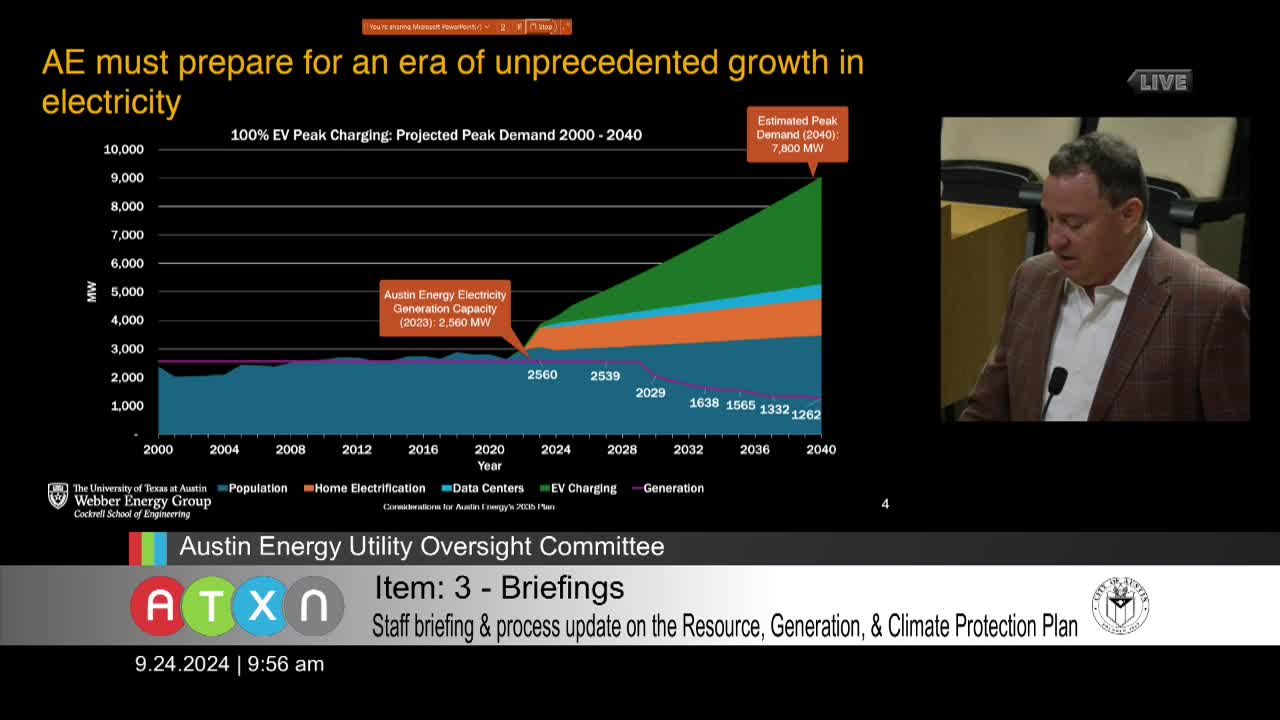Austin Energy braces for unprecedented growth in demand
September 24, 2024 | Austin, Travis County, Texas
This article was created by AI summarizing key points discussed. AI makes mistakes, so for full details and context, please refer to the video of the full meeting. Please report any errors so we can fix them. Report an error »

In a recent government meeting, officials discussed the anticipated surge in energy demand in Austin, driven by factors such as home electrification, data center growth, and electric vehicle (EV) charging. The conversation highlighted the need for Austin Energy to prepare for what was described as an \"era of unprecedented growth.\"
Key points included the potential impact of natural gas usage in homes, with heating and cooking still relying heavily on this resource. The discussion also touched on the expected demand from data centers, with projections estimating an increase of around 100 megawatts, influenced by advancements in artificial intelligence. A notable example cited was a single research computer at the University of Texas, which consumes 30 megawatts of power.
Electric vehicle charging emerged as a significant variable in future energy consumption. While a scenario where all EVs charge simultaneously was deemed unlikely, officials suggested that a more realistic expectation would see about 10% of EV owners charging at any given time. This could still lead to a doubling of load growth over the coming decades, emphasizing the importance of managing charging times to avoid peak demand issues.
Austin Energy's strategy moving forward will involve a dual approach to ensure resource adequacy—balancing supply and demand. This includes the development of various power generation options, such as thermal plants and renewable sources, alongside demand-side solutions like rooftop solar and energy efficiency measures.
The meeting underscored the environmental benefits of electrification, particularly in reducing emissions from gasoline vehicles, which are currently the largest source of pollution in the area. Transitioning to electric heating and cooking solutions is expected to further enhance air quality and reduce noise pollution.
Overall, the discussions pointed to a critical need for Austin Energy to adapt and expand its infrastructure to meet the growing energy demands while also addressing environmental concerns.
Key points included the potential impact of natural gas usage in homes, with heating and cooking still relying heavily on this resource. The discussion also touched on the expected demand from data centers, with projections estimating an increase of around 100 megawatts, influenced by advancements in artificial intelligence. A notable example cited was a single research computer at the University of Texas, which consumes 30 megawatts of power.
Electric vehicle charging emerged as a significant variable in future energy consumption. While a scenario where all EVs charge simultaneously was deemed unlikely, officials suggested that a more realistic expectation would see about 10% of EV owners charging at any given time. This could still lead to a doubling of load growth over the coming decades, emphasizing the importance of managing charging times to avoid peak demand issues.
Austin Energy's strategy moving forward will involve a dual approach to ensure resource adequacy—balancing supply and demand. This includes the development of various power generation options, such as thermal plants and renewable sources, alongside demand-side solutions like rooftop solar and energy efficiency measures.
The meeting underscored the environmental benefits of electrification, particularly in reducing emissions from gasoline vehicles, which are currently the largest source of pollution in the area. Transitioning to electric heating and cooking solutions is expected to further enhance air quality and reduce noise pollution.
Overall, the discussions pointed to a critical need for Austin Energy to adapt and expand its infrastructure to meet the growing energy demands while also addressing environmental concerns.
View full meeting
This article is based on a recent meeting—watch the full video and explore the complete transcript for deeper insights into the discussion.
View full meeting
